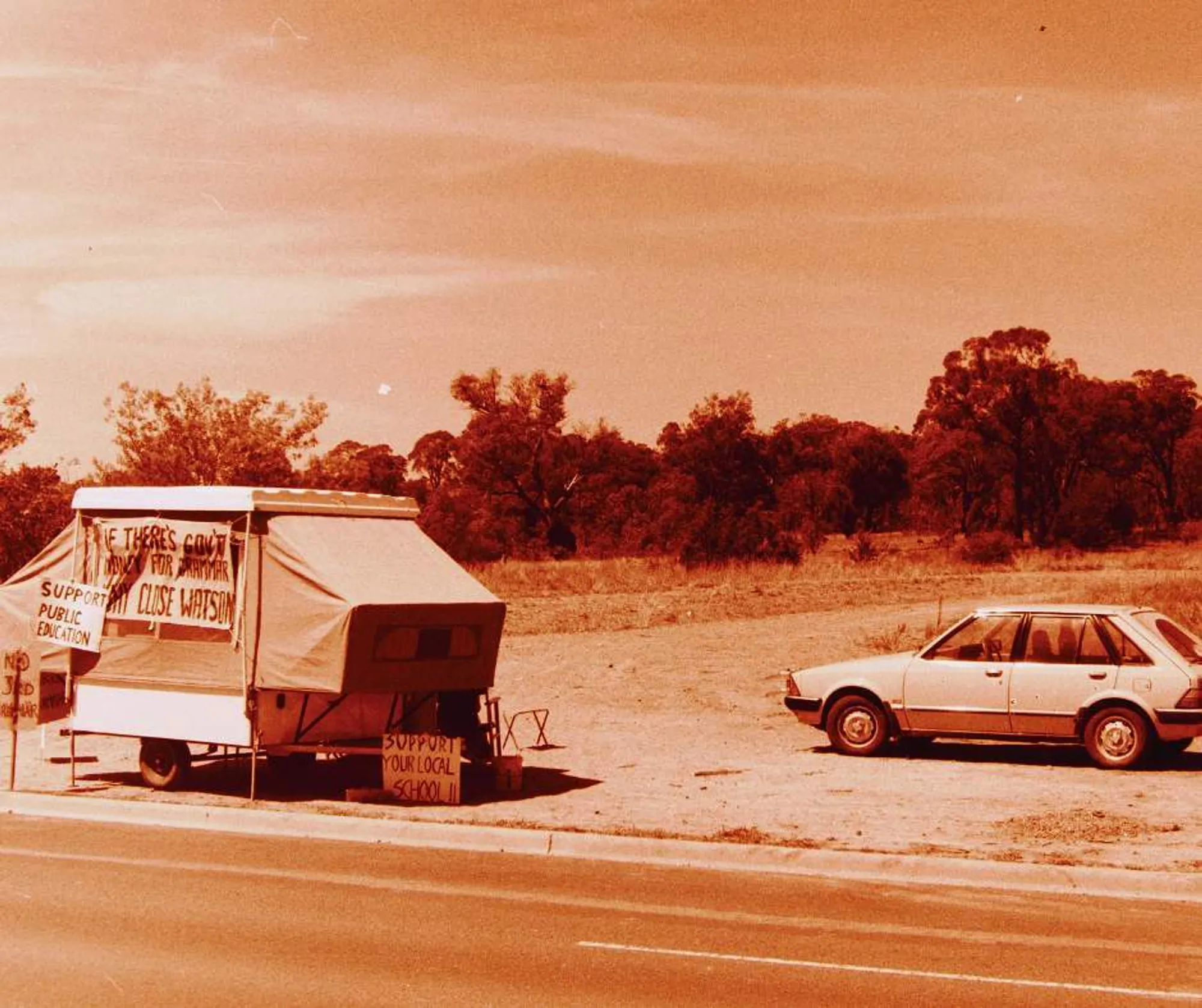Picket Lines and Protests
By Mrs Annette Carter, College Historian
The construction of Radford College was far from smooth sailing, halted for a significant period due to public opposition.
One newspaper reported in 1984 that “the name Radford is almost a household word in Canberra nowadays, even among people who have nothing to do with education”[1]. This was because of a long-running dispute between the Trades and Labour Council (TLC), the Australian Teachers’ Federation (ATF) and the ACT Council of Parents and Citizens Association (P&C Council) over its construction. While a report had already outlined that integration of all non-government school children in the ACT would cost an additional $16.7 million per year[2], several factors contributed to the long-running battle, including:
- Funding for existing schools and student retention.
- Use of government funds for a private school.
- The allocation of land by the National Capital Development Commission (NCDC).
It was felt that consultation between the local community, government and stakeholders had not been adequately sought. As the chairman of a later report identified: “Radford College, to its astonishment, became the case which showed the cracks in the existing edifice for planning and for funding schools”[3].
Two years before any construction took place, the P&C Council called a public meeting at Lyneham High School to discuss the threat to the viability of government schools due to the direct ‘competition’ from “small non-government schools”[4].
Not long after, in 1982, a decision was made to close Watson High School (it closed indefinitely in 1987). This led local school communities to further worry that the construction of a new school would put other schools at risk of closure.
The P&C Council was proactive and wrote to prominent stakeholders, including the Schools Commission, asking for a deferment on the decision about Radford College until a thorough impact study was undertaken[5].
The Federal Government funding of stage one had also been a point of contention. Radford College had been given a planning capital grant as well as interest subsidies. Wal Fife, the Federal Minister of Education, denied any preferential treatment[6], however, the P&C Council was “critical of the establishment of a new secondary school at a cost of millions of dollars of public expenditure in a declining enrolment area”[7] when there were stringent economic constraints on public spending for existing schools.
There was also some resentment over the NCDC allocating the 18-hectare site for the school. This land had originally been earmarked for medium-density housing and was valued at $3 million (in 1983) if it had been used for that purpose[8]. It was felt that such a large and well-allocated site was preferencing the new school, and there was added frustration that the re-routing of a public cycle path would come at the taxpayer's expense.
As a result of these issues, a motion was passed by the TLC endorsing “the call of the executive for bans on the construction of a third grammar school planned for the Belconnen area” and seeking the support of the ATF if there was any construction work on the site[9]. In turn, the ATF called on the Secretariat “to discuss with interstate and territory affiliates to picket line the third Grammar School”[10].

With discussions breaking down, a picket line was set up on 21 February 1983 to stop any construction at the site. Also present was a crowd of Radford College supporters.
Just over a month later, on 23 March 1983, the construction ban was lifted after TLC and ATF representatives met with Senator Ryan, then Minister for Education and Youth Affairs, and received assurances regarding resources, facilities, and funding for government education in the ACT[11].
These assurances led to the establishment of a committee that included members from the TLC, as well as representatives from the ACT School Authority, P&C Council, School Commission and Federal Government to review the development of Radford and to advise, among other things, on how disruptive effects could be avoided. T.B. Millar, chairman of Radford’s school board, agreed that they would “co-operate fully with the review committee. We hope it leads to the establishment of principles applicable to all schools in the ACT”[12]. His comment hints at what came out as a central recommendation from the Impact Review - that a planning authority was needed for all schools in the ACT[13]. The report determined that the government was committed to the promised capital funding, but only for stage one, covering students in Years 7 to 9[14] and that an impact study should be carried out before a decision was made about the provision of capital funds for further year levels.
The tense situation continued to play out in the media, with further delays in 1985 when TLC voted to ban further development at Radford until adequate funds for ACT Government schools were provided and other sites away from Lake Ginninderra were sought for a planned secondary school[15]. The TLC eventually made a deal with the government to allow for further construction at Radford College (for Year 10) if there were supported moves to have the remaining Lake Ginninderra foreshore designated as parkland. The Year 10 stage was paid for by parent contributions, and Willett, the Chair of the Board at the time, took the opportunity to highlight that “Each place we provide will save the government money and means that more will be available for the government school system”[16].
Radford College paved the way for the construction of new Anglican schools. Consequently, Burgmann Anglican School, the fourth Anglican school in Canberra, was constructed in 1998, and Stromlo Forest Anglican College is due to begin stage one of construction in 2026.
References:
[1] W. C. Stegemann. “Who was Radford, for whom a new college is named?” The Canberra Times, 11 Feb 1984, p. 15.
[2] “Integration of Schools” The Canberra Times, 22 Aug 1983, p. 2.
[3] Don Anderson. “Lack of effective authority in Canberra blamed for Radford College dispute” The Canberra Times, 16 Sep 1983, p. 2.
[4] Marion Gorrie, (1981, Nov 18), [Memo to P&C Presidents and Delegates]. ACT Council of Parents and Citizens Association. Noel Butlin Archives. N85.
[5] [P&C Feedback], (1982, Mar). ACT Council of Parents and Citizens Association. Noel Butlin Archives. N85.
[6] Wal Fife, (1982, 8 Jan), [Letter to Marion Gorrie]. ACT Council of Parents and Citizens Association. Noel Butlin Archives. N85.
[7] Marion Gorrie, (1982, Feb 18), [Letter to Bishop Warren]. ACT Council of Parents and Citizens Association. Noel Butlin Archives. N85.
[8] Joan Corbett, (1983, Nov 8), [Response to the Anderson Committee on Radford College from ATF to Senator Ryan]. ACT Teachers’ Federation. Noel Butlin Archives. N85.
[9] [Motion by TLC], (1982, Mar 17), Trades and Labour Council. Noel Butlin Archives. Z147.
[10] Robert Bluer, (1983, Jan 25), [Letter to Senator Baume], ACT Teachers’ Federation. Noel Butlin Archives. N85.
[11] Lisa Perry. “Grammar school bans are lifted” The Canberra Times, 23 Mar 1983, p. 1.
[12] “Committee on Radford College appointed” The Canberra Times, 20 Apr 1983, p. 3.
[13] Don Anderson. “Lack of effective authority in Canberra blamed for Radford College dispute” The Canberra Times, 16 Sep 1983, p. 2.
[14] Ray Costello, (1983, Mar 18). [Minute from Office of the Minister for Education]. ACT Teachers’ Federation. N85.
[15] “Radford College bans ‘may harm students soon’” The Canberra Times, 13 Feb 1985, p. 1.
[16]
“Radford welcomes senior years” The Canberra Times, 22 Mar 1986, p. 15.
